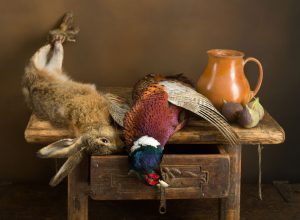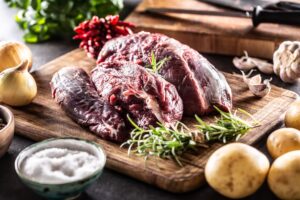Check this out!
The term “wild game” might scare you, or it may prompt you to recall fond memories of hunting with dad, or drying venison into jerky with mom. Many may have never done it though. Perhaps you grew up in the city, or it just wasn’t your thing. For a multitude of reasons, we as a society have seemed to stray from taking down and preparing our own meat. In fact, it’s likely many of us have never even thought of doing so, but why not!? Don’t let it scare you! For instance, deer season is huge in my state of Michigan and canning and preserving venison is second nature to many hunters!
What is Venison?
Wild game, like venison, elk, moose, or water fowl, is surprisingly healthy for you in comparison to other meat products. For now, we will focus on venison. First and foremost, it’s drug free. You would be hard-pressed to find, say, a deer, that has been injected with hormones or steroids. Nope, that massive buck is all natural and lean…and that alone should make your mouth water! Second, venison is the perfect meat if you’re trying to get lean yourself. In a single serving, it has less calories than beef, chicken, turkey, or lamb and it’s a complete protein. Game contains less total saturated fat as compared to commercial red meats, and its super high iron and vitamins B12 and B13 content will also help you fight fatigue and regulate the metabolism better than others.
What Does Venison Taste Like?
Now for the part individuals usually either love or hate– flavor. Speaking to venison specifically, most first-time consumers are turned away due to its “gamey” or musky flavor. Much like any other meat, venison’s flavor is determined by what the animal eats. As “wild” implies, you don’t really have much say here unless you plan on raising it in your back yard. And to that, I’d say “good luck” to you! An animal that consumed mostly corn will lead to a milder flavor, while those that ate acorns will have that characteristic gaminess. Mule deer feed on sage plants, so I bet you can guess what their meat tastes like…an overabundance of sage leaves. It’s up to you which you prefer, but remember that either way you choose, proper preparation will help you reach your perfect outcome. For instance, may soak their venison in a brine ratio or in milk prior to preparing.
So, what is that “perfect outcome”? For me, it’s home canned Venison Steak Diane – and no, I am not bias because the recipe name boasts my first name. The truth is, the brandy sweetens the venison while the pressure canner tenderizes the meat. Give her a go – you won’t be disappointed.
Home Canned Venison Steak Diane Recipe
Makes approximately 4 quarts or 8 pints
Prep Time: 10 min / Cook Time: 15 min / Canner Time: 60 min / Processing Time: 90 mi/75 min / Total Time: 175 min/160 min
Melt-in-your-mouth venison medallions are a dream in this delicious recipe. While the onions, Dijon, and Worcestershire give this wild game version a kick, the brandy compliments the venison superbly. As discussed, any cut of meat will tenderize when pressure canning, but there is something to be said for using backstrap or tenderloin. This is also the option to use tougher cuts of venison like neck meat, as it tenderizes nicely while pressure canning.
Ingredients
- 3 tablespoons olive oil
- 3 to 5 pounds venison backstrap or tenderloin, cut into 2½-inch medallions
- 1 teaspoon coarse sea salt
- ½ teaspoon ground black pepper
- 1 cup brandy
- 1 cup diced sweet onion
- 4 garlic cloves, minced
- 2 shallots, finely chopped
- 3 tablespoons Worcestershire sauce
- 2 tablespoons Dijon mustard
- 1 quart Beef Broth
- ¾ cup tomato paste (6 ounces)
Instructions
- In a skillet, starting with 1 tablespoon oil, brown the venison in batches on medium-high heat until all the venison is lightly browned, about 3 to 5 minutes per batch. Season each batch with a dash of sea salt and pepper. Remove each batch from the stockpot and place in a bowl. Be sure not to fully cook the meat.
- Add the brandy to the skillet, and on high heat, deglaze being sure to scrape all the drippings the bottom of the pan.
- In a large stockpot, add the browned venison and the deglazed drippings from the skillet. Add the onion, garlic, shallots, Worcestershire, and Dijon mustard, mix well. Bring contents to a boil on medium-high heat for 5 minutes. Whisk together the beef stock and tomato paste and add to stockpot. Return to a boil for an additional 5 minutes, mixing well.
- Using a slotted spoon, fill each hot jar ¾ full of venison. Ladle the hot cooking liquid over the mixture, leaving 1 inch of headspace. Remove any air bubbles and add additional liquid if necessary to maintain the 1 inch of headspace.
- Wipe the rim of each jar with a warm washcloth dipped in distilled white vinegar. Place a lid and ring on each jar and hand tighten.
- Place the sealed jars in the pressure canner, lock the pressure canner lid, and bring to a boil on high heat. Let the canner vent for 10 minutes. Close the vent and continue heating to achieve 11 PSI for a dial gauge and 10 PSI for a weighted gauge. Process quart jars for 90 minutes and pint jars for 75 minutes.
Serving Tip: When heating a quart on the stovetop, be sure to add ¼ cup heavy whipping cream and mix well and finish heating through, about 3 minutes. Do not boil the cream. Serve this dish hot and garnish with fresh cut herbs like parsley, basil or diced chives.
For more wild game and meat canning recipes be sure to pick up your copy of The Complete Guide to Pressure Canning on Amazon or Barnes & Noble today. Have a canning question? Do not hesitate to message me on Facebook.
Happy Canning Everyone~
Diane, The Canning Diva®


